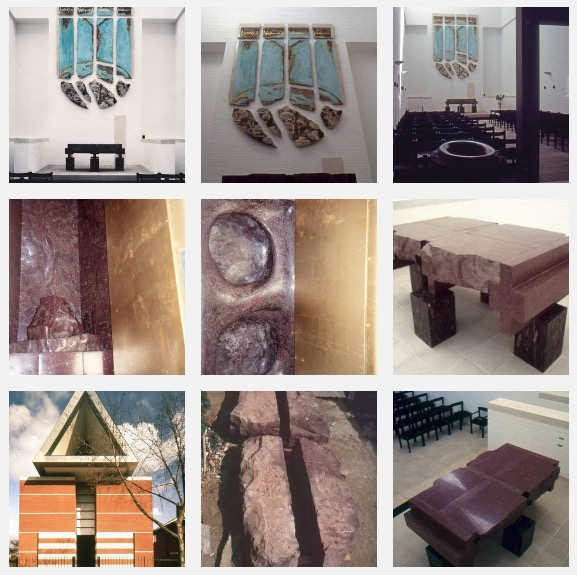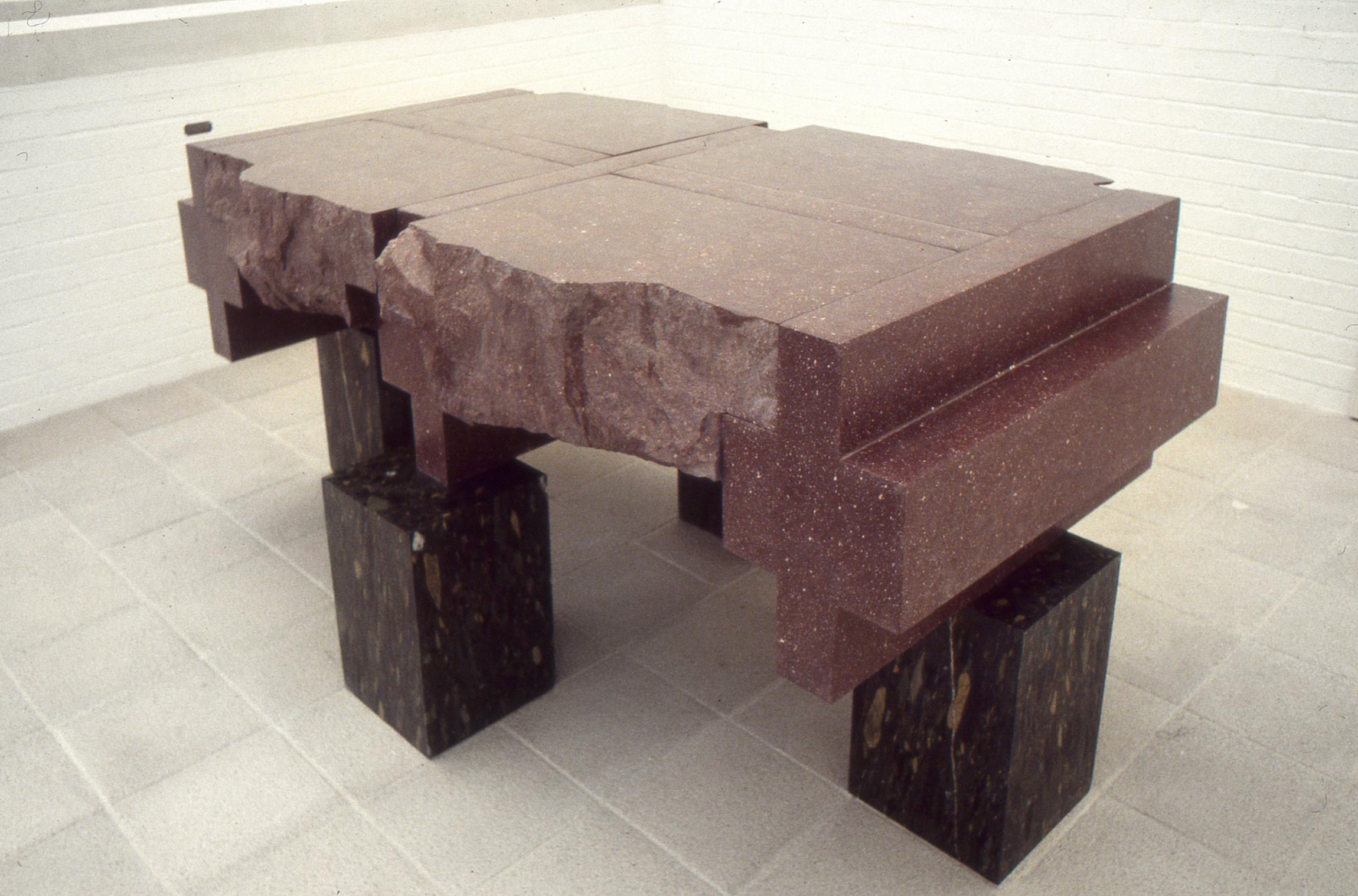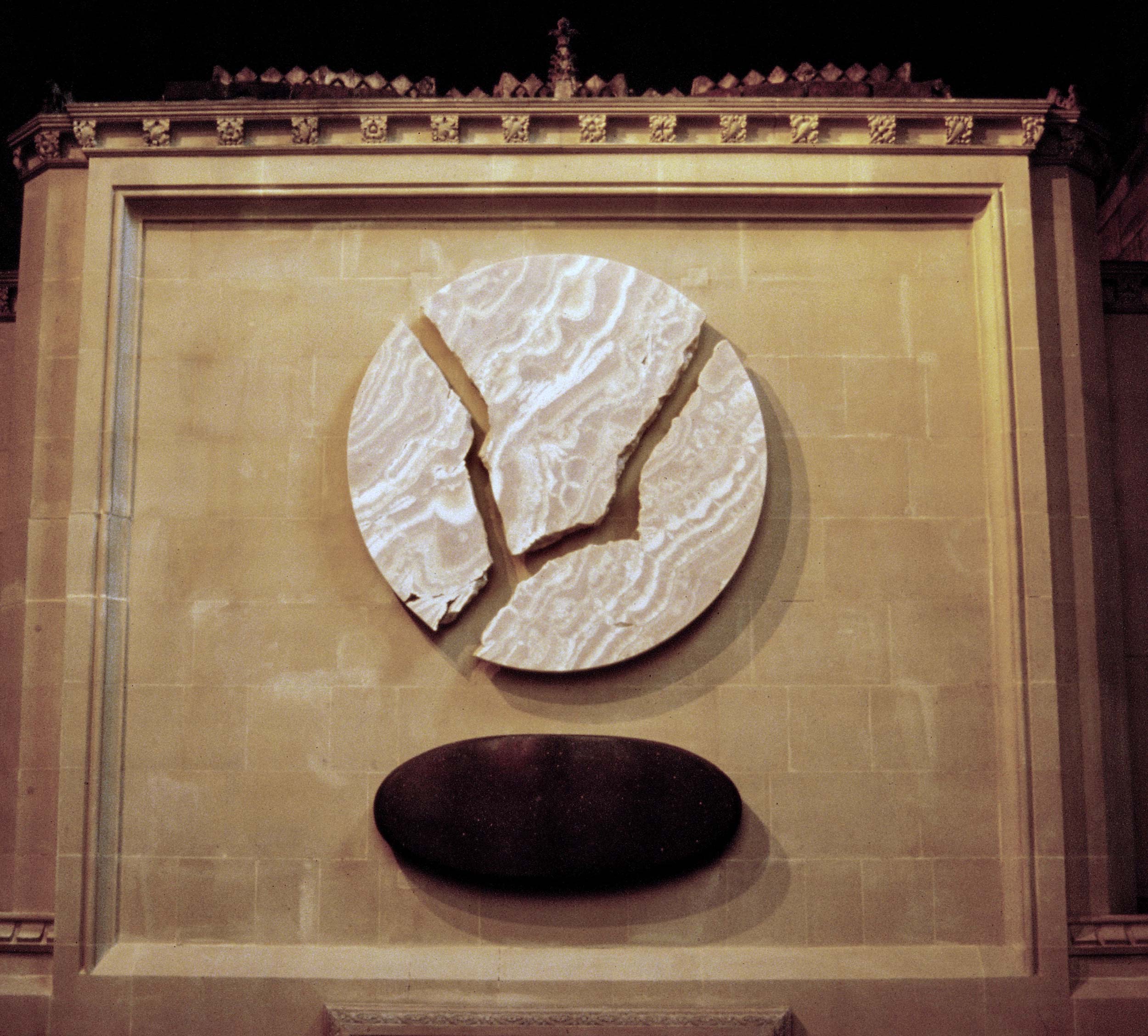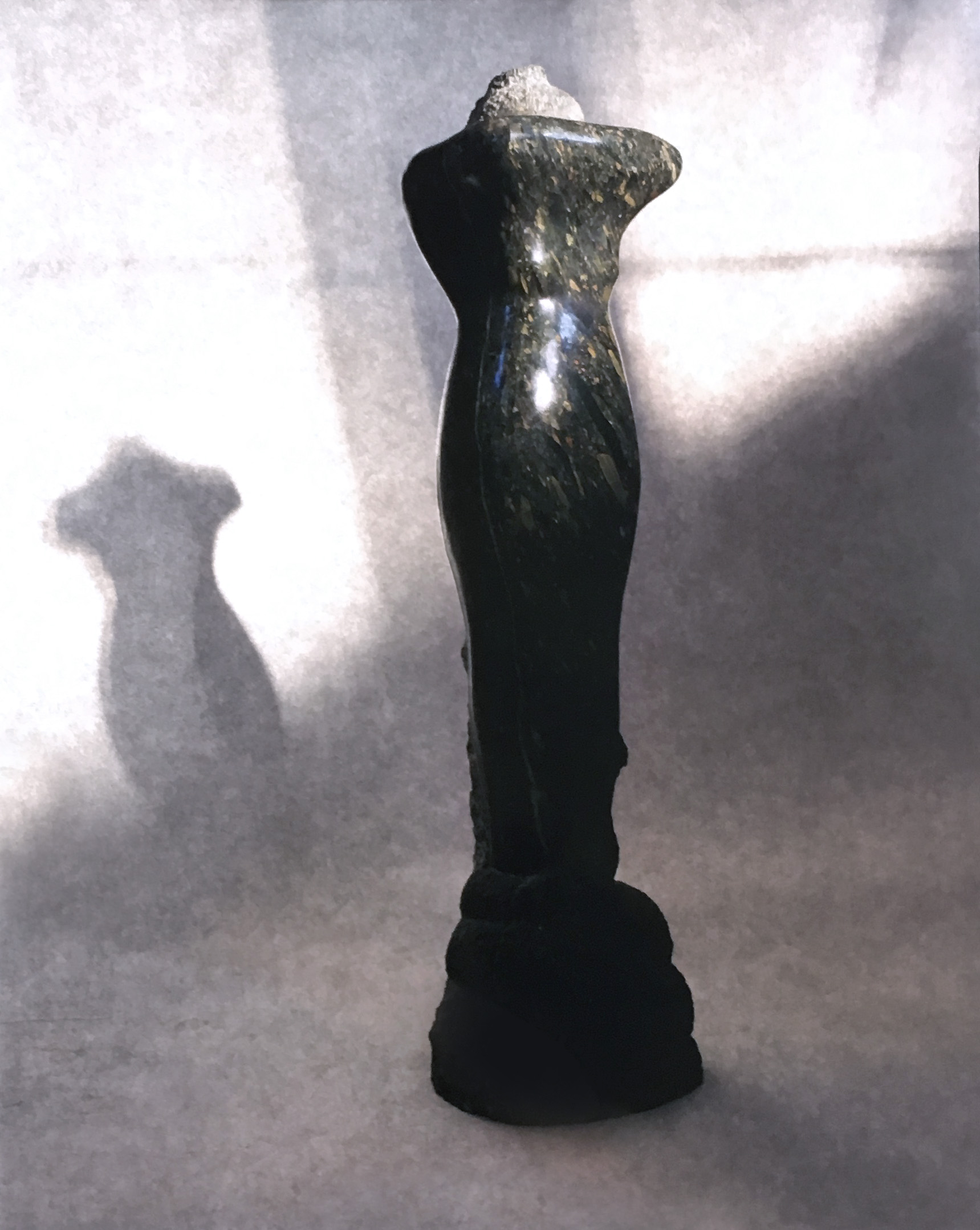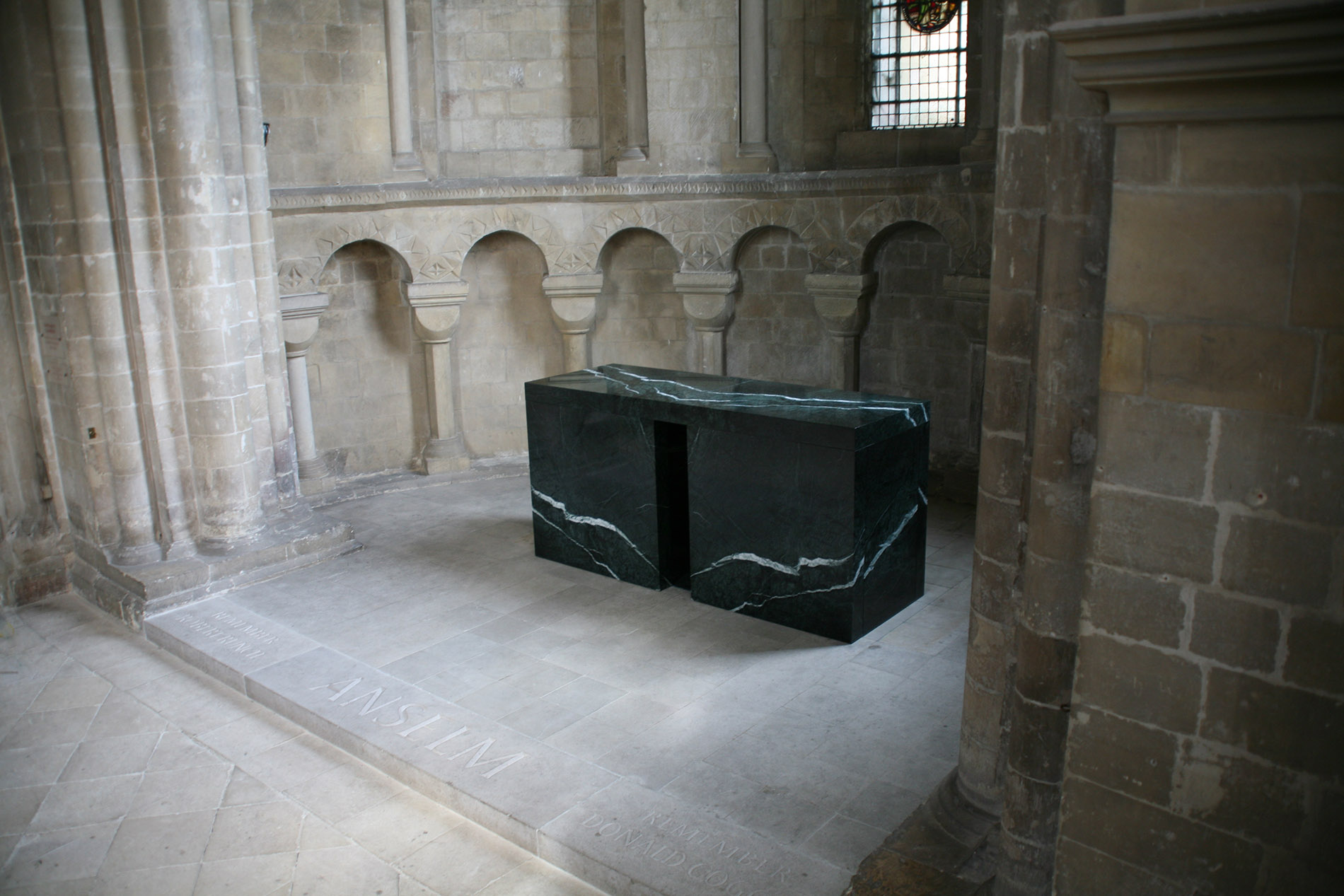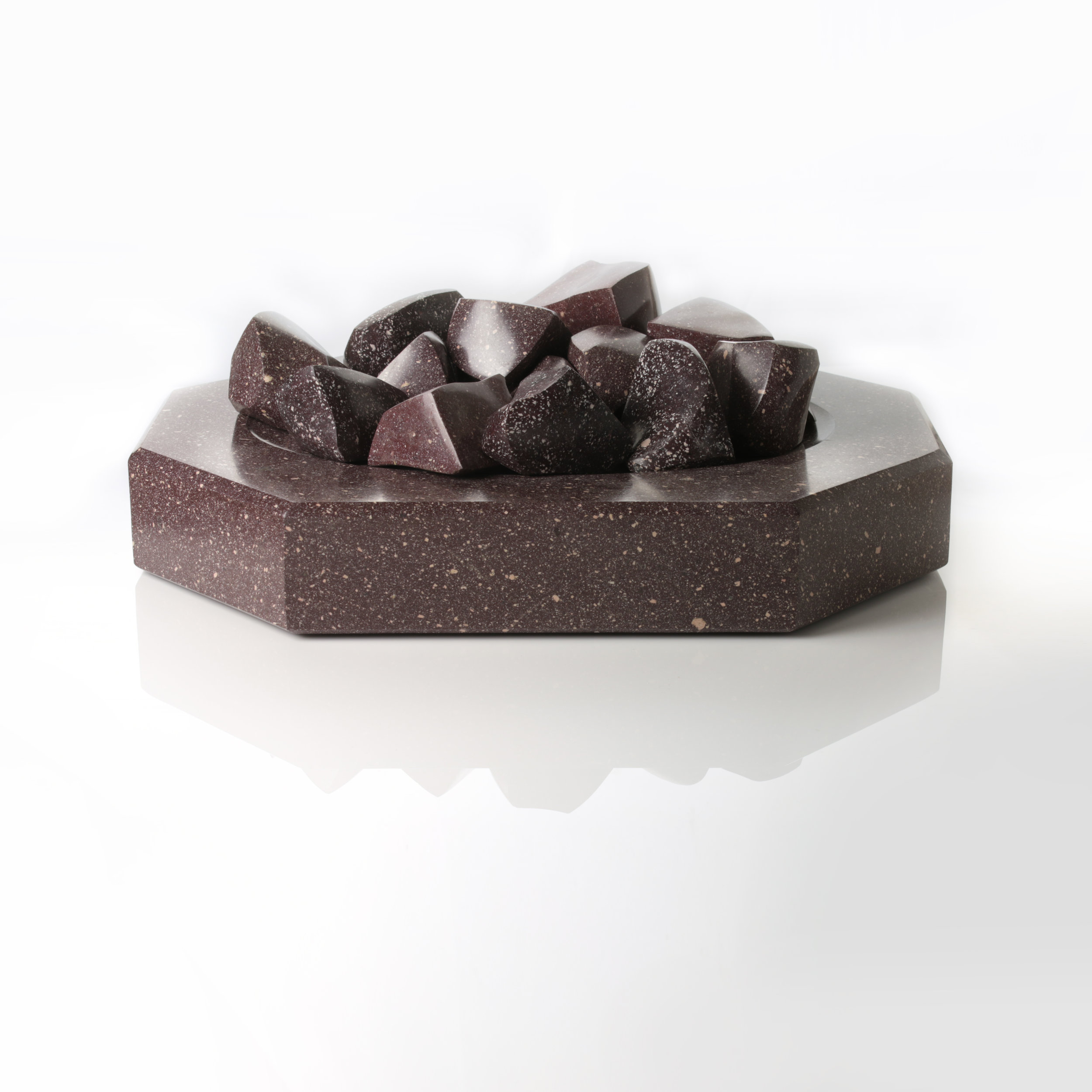
Reredos: Christ the Saviour of the World, 1993
Reredos: Christ the Saviour of the World, 1993
Travertine with ciment fondu, oxides and gold leaf
480 x 325 x 13 cm
The Parish Church of St. Paul Harringay, 1993
Reredos: Christ the Saviour of the World, 1993
Travertine with ciment fondu, oxides and gold leaf
480 x 325 x 13 cm
Altar, 1993
Imperial porphyry and Hammamat breccia
95 x 206 x 119 cm
Font, 1993
Imperial porphyry and Hammamat breccia
110 x 88 x 59 cm
The Parish Church of St Paul, Harringay, London
Putting High art above the altar
by Richard Dorment
Whenever I hear talk of the consolations of art I begin to smell a phoney. Great works of art never console anybody religion does and the one is not a substitute for the other. Of course, I am not saying that works of art have no place in worship- rather that aesthetic quality has very little to do with either creating or sustaining faith.
You have only to walk into any church in Rome or Florence to prove the point. Tourists crowd around the Massaccio or the Caravaggio, but the people actually praying kneel before the plaster saint with the painted face. In the church of Santa Maria Sopra Minerva in Rome it is not Michelangelo;s statue of the Risen Christ that is surrounded by candles and flowers but a saccharine 19th century image of the sacred Heart.
The last important religious painter was Rouault. Mark Rothko’s non- denominational chapel in Houston may be an artistic triumph, but it subverts the central issue of religious faith, being dedicated not to the contemplation of God's presence, but of His absence. In terms of its function as sacred art, the 14 canvases which make up Barnett Newman's ‘Stations of the Cross’ in the National Gallery in Washington are more successful. Newman brilliantly used the most minimal means- colours, stripes and the occasional spatter of paint - to evoke the Crowning of Thorns, Mocking of Christ and Crucifixton. Still consolation? I don't think so.
Here in Britain, Epstein, Sickertt, Spencer and Sutherland all tried their hands at religious art, each self- consciously trying to breath new life into an exhausted visual tradition. In the art of our own time I respect Christian Boltanski's assemblages of photos and lights in church interiors- but not much else. Recent exhibitions of sacred art in the Cathedrals of Lincoln, Worcester and St Paul's merely demonstrate how embarrassing this kind of subject can be when not done well. And; when I hear of an abstract painting by Therese Oulton being hung over the high altar at Tewkesbury Abbey, I leave the room.
That is why a project in a quiet back street off the Seven Sisters Road in Tottenham is so interesting. St Paul's Church Harringay constitutes one of the most original acts of patronage by the Church of England since the Second World War. The architect Peter Jenkins and sculptor Stephen Cox create an interior which invites meditation on the oldest subject on Christian art: Christ's Sacrifice on the Cross. In 1984, the Gothic Revival church of St Paul's burnt to the ground. The commission to design a new church was awarded to the firm of Inskip & Jenkins. Working on a very limited budget, Peter Jenkins designed a modern brick building based on the plan of an early Christian basilica, the kind in which St. Paul might have preached. Windowless from the outside the interior is bathed in diffused natural light from huge triangular skylights in the roof. the walls are white and, the seating black. The effect is a bit like entering a whitewashed church in Greece.
What pulls the severe interior together is Cox's remarkable sculptural contribution, a monumental altar made of rare imperial porphyry, above which hangs a jagged sculptural reredos of travertine stone. Blending together mediums of sculpture and painting, Cox then stained the stone with copper and iron oxides to depict the crucifixion. Against a simple white background the resulting blues and rust browns register with dramatic force.
Cox is one of the most respected sculptors working in Britain today and one whose art I ardently admire. But I have to admit I was surprised to find him working in a specifically Christian context, because he is best known for his stone carvings based on the sensual art of Southern India. Typical visual sources range from erotic carved temple reliefs to stone lingams, and he has been known to anoint his own statues with oil and drape them in brightly coloured cloths.
Cox's art deals with eternal themes using conventional stone carving techniques but more than this it is founded on the profound questions he asks about the meanings of the sacred forms that inspire him. The best I can do to describe his work is to say that he has a feeling for the holy. Though at first his sculptures look simple the more you look at them the more mysterious they become.
This is particularly true at Harringay. Cox begins by literally turning Christian iconography upside-down. His reredos takes the form of a traditional Italian Renaissance altarpiece, but turned on its head with the arch at the bottom. the monumental crucifixton shows Christ from behind as though looking down over the Earth, which is depicted in the lower half of the reredos. Were the priest to celebrate mass in a the traditional position with his back to his congregation, the act would take on additional resonance when performed under this haunting image. An important theme in the reredos is fragmentation. The upper section is divided into four parts in such a way that the spaces between the stones form three crosses. The broken sections below suggest both the great rivers of the ancient world and a shattered universe. Closer up, one sees that the globe is actually a map of the Roman empire on which the names of the cities in which St Paul preached are inscribed in Greek letters. In this way, Cox emphasises the church's historical origins in the early Christian world.
Equally impressive is the altar, four rectangles made of breccia a funeral stone used by the ancient Egyptians, surmounted by three chunky stone crosses and held together by the great slab or porphyry quarried in Egypt and carved into a magnificent sacrificial table. Cox's sensitivity both to material and form is also evident in the contrasting shape of the baptismal font at the back of the church. Carved from the same stone slab as the altar, it is literally a chip off the old block, but is ovoid in shape and exquisiteley poised on top of a black rectangle.
Everything about Cox's work, from the material from which it is made to its shape laden with symbolic content both religious and historical. Though consolation is not the right work, I can well imagine that art of this quality has the power to lead the believer to prayer and meditation.
Altar, 1993
Imperial porphyry and Hammamat breccia
95 x 206 x 119 cm
The Parish Church of St Paul, Harringay, London
Eucharist, 1996-7
Imperial Porphyry and Alabaster
The Cathedral Church of St. Nicholas, Newcastle upon Tyne
St Anselm's Altar, 2005
St Anselm's Altar, 2005
St. Anselm's Chapel, Canterbury Cathedral
More works in Canterbury:
Cruel Stones of St. Stephen, 2007
Cruel Stones of St. Stephen, 2007
Carved Egyptian porphyry
Height 16cm (6 1/4") Width 47cm (18 1/2") Depth 35cm (13 3/4")
This work is currently on show with Adrian Sassoon, London.
I stood outside a gate of Jerusalem at the spot where my namesake was stoned to death. The emotion was of horror of a world past and the use of porphyry appropriate to a commemoration of that moment.
Egyptian porphyry was exclusive in the Roman Imperial era and, after the conversion of Constantine, became symbolic of the Holy Blood of Christ and significant in church decoration through the Byzantine era. I have used Egyptian porphyry for a number of sculptures representing saints’ ‘attributes’; griddles dedicated to St Lawrence, the Sword of St George, and the Lance of St Thomas amongst others.
This sculpture dedicated to Stephen has added poignancy in a world where stoning to death is not an act of the distant past.
Trinity Crucifixion, 2008
Trinity Candelabra with Crucifixion at St Helier Jersey, 2008
Imperial porphyry, gilt wood frame
Processional Crucifix, 2019
Processional Crucifix, 2019 at Holy Trinity.
Commissioned by a chaplain of an Oxford College
Imperial Porphyry




